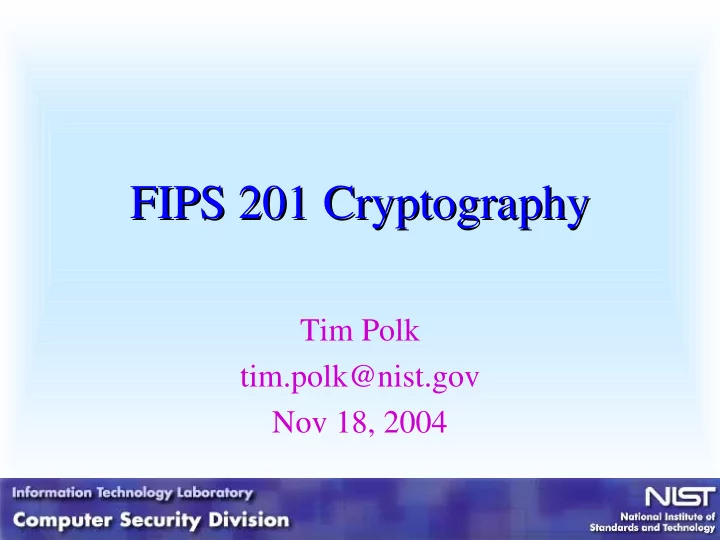

FIPS 201 Cryptography FIPS 201 Cryptography Tim Polk tim.polk@nist.gov Nov 18, 2004
Cryptography in FIPS 201 Cryptography in FIPS 201 • Digital signatures on logical credentials o CHUID, X.509 certificates, biometrics • Cryptographic key(s) o One mandatory PIV asymmetric authentication key • May be used to sign an externally provided hash o Optional symmetric and asymmetric keys • Symmetric or asymmetric key for challenge response protocols • Asymmetric keys for digital signatures and key management • Symmetric key for card management
Digitally Signed Credentials Digitally Signed Credentials • CHUID and biometrics employ CMS external detached signature • X.509 Certificate signature formats as specified in RFC 3279 o 1024 or 2048-bit RSA/160 or 224-bit elliptic curves o For RSA: SHA-1 or SHA-256 hash o For ECDSA: SHA-1 or SHA-224 hash
X.509 Certificates X.509 Certificates • PIV Authentication Certificate o keyUsage asserts digitalSignature but NOT nonrepudiation o Certificate includes FASC-N from CHUID in altSubjectName • Digital signature and Key management certificates • Asymmetric challenge-response key
Cryptographic Keys Cryptographic Keys • On-card key generation for PIV authentication keys and optional digital signature key pair o RSA or elliptic curve key pairs • Import symmetric authentication and card management keys o Triple DES or AES • Import or generate asymmetric key management keys o RSA or elliptic curve key pairs • All private/secret key computations on-card • Message hashing off-card
Key Sizes Key Sizes • Key sizes transition in 2008 and 2010 Initial Key Sizes Key Sizes after 2008/2010 Two and Three Key Triple DES Three Key Triple DES AES-128, AES-192, and AES-256 AES-128, AES-192, and AES-256 1024 and 2048 bit RSA 2048 bit RSA 160 and 224 bit elliptic curve 224 bit elliptic curve SHA-1, SHA-224 and SHA-256 hash SHA-224 and SHA-256 hash
Cryptographic Operations Cryptographic Operations • Initially permits 80-bit or stronger cryptography o On card • Two and Three Key Triple DES • AES-128, AES-192, and AES-256 • 1024 and 2048 bit RSA • 160 and 224 bit elliptic curve o Off card • SHA-1, SHA-224 and SHA-256 hash
FIPS 140 validation required for FIPS 140 validation required for all cryptographic operations cryptographic operations all • Level 3 Physical Security • Level 3 Operator Authentication • Level 2 Overall
Open Issues Open Issues • Contactless asymmetric cryptography • Primes Testing for RSA • Random Number Generation
Contactless Cryptography Cryptography Contactless • Efficiency o Will the electrical power available to the card be sufficient to implement a cryptographic challenge-response protocol? o Will the time required at the gate exceed human patience?
Primes Testing for RSA Primes Testing for RSA • Tests for prime numbers are specified in FIPS 186-2, X9.31, X9.80 • Is X9.31 primes testing practical for PIV cards? o What performance numbers can be achieved for generation of 2048 bit keys?
Random Number Generation Random Number Generation • NIST is developing new standards for random number generation within ANSI o Target delivery late 2005 o Will impact CMVP validation requirements • Sources of randomness for PIV cards? o On-card hardware RNG o Vendor installed seed with PRNG • Vendor installed seed precludes non-repudiation!
Recommend
More recommend